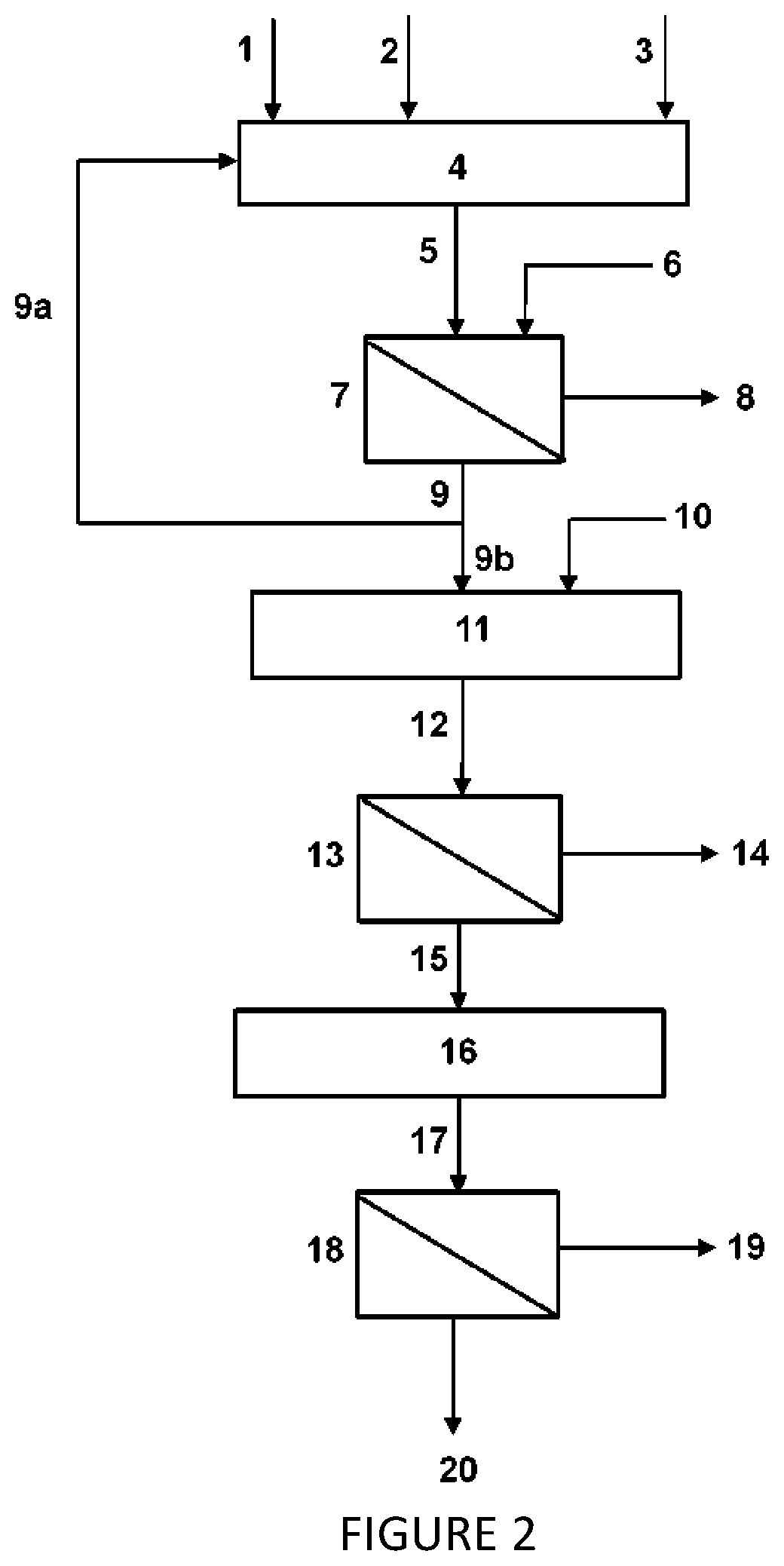Method for removing arsenic from materials containing same
a technology of arsenic and materials, applied in the field of methods for removing arsenic from materials containing same, can solve the problems of inability to directly send to the smelter, inability to use low-arsenic concentrates, and difficulty in mixing, so as to improve the stability of precipitate, and reduce the residual arsenic levels
- Summary
- Abstract
- Description
- Claims
- Application Information
AI Technical Summary
Benefits of technology
Problems solved by technology
Method used
Image
Examples
example 1
on with Pure Oxygen. Study of the NaOH Dose and the Liquid-Solid Ratio
[0099]In this example are shown the experimental trials carried out to define the NaOH dose necessary for the lixiviation step for a copper concentrate with 31.6% copper and an arsenic content of 2.75% as enargite. Once the dose necessary for the lixiviation of arsenic was obtained, the influence of the percentage of solid in the pulp on the efficiency of arsenic extraction was studied. The temperature, residence time, and oxygen overpressure were kept constant throughout these trials.
[0100]
TrialsUnits1234567VariablesLiquid-solid ratiomL / g22234610Lixiviating reagent***NaOHNaOHNaOHNaOHNaOHNaOHNaOHDose of lixiviatingkg / kg As22.219.057.6122.222.222.222.2reagentLixiviation temperature° C.160160160160160160160Oxidizing gas***O2O2O2O2O2O2O2Overpressure of oxidizingpsig80808080808080gaskPa551.6551.6551.6551.6551.6551.6551.6ResultsArsenic removal%98.780.753.396.482.874.147.6
[0101]It is concluded from this example that the...
example 2
on with Pure Oxygen. Study of the Process Kinetics
[0102]This example shows the experimental trials carried out with the aim of studying the arsenic dissolution kinetics from the same copper concentrate as in example 1. The temperature, solid-liquid ratio of the pulp, and oxygen overpressure were kept constant throughout these trials.
[0103]
TrialsUnits89101112VariablesArsenic in initial solid%2.82.82.82.82.8Lixiviating reagent***NaOHNaOHNaOHNaOHNaOHLixiviation temperature° C.160160160160160Lixiviation timeMinutes3060120150180Oxidizing gas***O2O2O2O2O2Overpressure of oxidizingpsig8080808080gaskPa551.6551.6551.6551.6551.6ResultsArsenic in final solid%0.70.50.50.30.2Arsenic removal%75.581.582.888.692.6
[0104]It is concluded from this example that good results are achieved with a lixiviation time of 60-180 minutes.
example 3
Study
[0105]In these trials, the effect of the use of liquors generated in previous trials (Trials 11 and 12 respectively) for the dissolution of arsenic from a copper concentrate (in Trials 13 and 14 respectively) was studied. The temperature, the residence time, the solid-liquid ratio of the pulp, and the oxygen overpressure were kept constant throughout these trials, and the concentration of sodium hydroxide was fixed by Trials 11 and 12.
[0106]
TrialsUnits1314VariablesArsenic in initial solid%2.82.8Liquid-solid ratiomL / g44Volume of recycled mother liquor%6718Volume of recycled wash liquor%167Volume of fresh lixiviating solution%1775Lixiviation temperature° C.160160Oxidizing gas***O2O2Overpressure of oxidizing gaspsig8080kPa551.6551.6ResultsArsenic in final solid%0.40.4Arsenic removal%86.885.2
[0107]This example shows that a recycled solution can be used efficiently.
PUM
| Property | Measurement | Unit |
|---|---|---|
| temperature | aaaaa | aaaaa |
| temperature | aaaaa | aaaaa |
| pressure | aaaaa | aaaaa |
Abstract
Description
Claims
Application Information
 Login to View More
Login to View More - R&D
- Intellectual Property
- Life Sciences
- Materials
- Tech Scout
- Unparalleled Data Quality
- Higher Quality Content
- 60% Fewer Hallucinations
Browse by: Latest US Patents, China's latest patents, Technical Efficacy Thesaurus, Application Domain, Technology Topic, Popular Technical Reports.
© 2025 PatSnap. All rights reserved.Legal|Privacy policy|Modern Slavery Act Transparency Statement|Sitemap|About US| Contact US: help@patsnap.com



